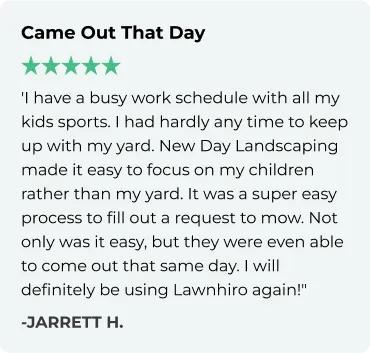
Everything You Need to Know About Fall Lawn Care, from Fort Worth Lawn Professionals
As someone who's been caring for Bermuda, St. Augustine, and Zoysia lawns across Fort Worth, Benbrook, and Crowley for years now, I can tell you that fall lawn care in Texas is completely different from what you'll hear about up north. I'm Cole A from New Day Landscaping, and after working with over 100 local families to maintain healthy Texas lawns, I've learned that understanding our warm-season grasses is the key to year-round success.
I recently watched a great video from Ryan Knorr Lawn Care about fall lawn programs, and while Ryan knows his stuff for cool-season grasses up north, here in Texas we're dealing with a completely different situation. Our Bermuda and St. Augustine grasses are winding down for winter dormancy, not gearing up for a second growth phase like northern grasses.
Why Fall Lawn Care is Different in Fort Worth
Here in North Texas, we're dealing with warm-season grasses that have completely different needs than what you'll see in northern states. Our Bermuda grass, St. Augustine, and Zoysia are starting to slow down their growth as temperatures drop, preparing for winter dormancy. This means our fall strategy is about helping them store energy and nutrients to survive winter and come back strong in spring.
Unlike cool-season grasses that get a second wind in fall, our Texas grasses are essentially getting ready for their "hibernation" period. This changes everything about timing, fertilization, and what we're trying to accomplish during these cooler months.
Understanding Texas Grass Dormancy Patterns
One thing I always explain to my clients – your Bermuda grass is supposed to turn brown in winter. That's not dead grass, that's dormant grass. Same with Zoysia. St. Augustine holds some color longer, but it still slows way down once we start getting consistent temperatures in the 50s and 60s.
With our 95% retention rate, I've learned that setting proper expectations about dormancy is crucial. Homeowners who understand this cycle don't panic when their lawn starts changing color in November and December. They know it's going to come back with a vengeance once we hit those consistent 70-degree days in spring.
Fall Fertilization for Warm-Season Texas Grasses
This is where Texas lawn care really differs from northern advice. While Ryan's video talks about heavy fall feeding, that approach would be completely wrong for our Bermuda and St. Augustine. Here's what actually works in Fort Worth:
Final Summer Feeding (Late August/Early September)
Your last heavy feeding should happen while it's still hot – usually late August or early September when temperatures are still consistently in the 80s and 90s. This gives your grass the nutrients it needs to finish strong before dormancy.
Pre-Dormancy Application (October/November)
Once daytime temperatures start staying in the 70s, it's time for your pre-dormancy feeding. This should be lower in nitrogen but higher in potassium to help with winter hardiness. I usually recommend something like a 3-1-2 or 4-1-2 ratio fertilizer during this window.
The key is avoiding high-nitrogen fertilizers late in the season. Pushing growth when your Bermuda or St. Augustine is trying to shut down for winter can actually make it more susceptible to freeze damage.
Timing Your Fall Lawn Care for Texas Weather
Our Fort Worth climate creates some unique timing challenges. We might have 90-degree days in October followed by a hard freeze in November. Here's how I time fall lawn care for North Texas conditions:
September: Final summer feeding while grass is still actively growing
October: Pre-dormancy fertilization and any needed overseeding
November: Final mowing and winterization
December: Clean-up and preparation for dormancy
This timeline can shift depending on when our first frost hits, which varies significantly year to year here in North Texas.
Aeration and Overseeding in Texas
Our clay soil still needs aeration, but the timing and approach are different than up north. For warm-season grasses in Fort Worth:
Aeration timing: Late spring through early fall while grass is actively growing
Overseeding: Best done in late spring, not fall (our grasses establish better in warm weather)
Core aeration benefits: Still crucial for our compacted clay, just timed differently
At New Day Landscaping, we often recommend spring aeration because our warm-season grasses recover much better when they're in active growth mode, not when they're preparing for dormancy.
Winterization for Bermuda and St. Augustine
Here's what actually helps Texas lawns prepare for dormancy:
Potassium feeding: Helps with winter hardiness and faster spring green-up
Final cut height: Leave Bermuda slightly longer (2-2.5 inches) going into winter
Irrigation adjustment: Reduce watering frequency as growth slows
Debris removal: Keep fallen leaves off dormant grass
Dealing with Fort Worth's Unique Challenges
Our local conditions create specific challenges that generic lawn advice doesn't address:
Clay soil: Holds water but compacts easily, affecting root development
Alkaline soil: Common in North Texas, can cause iron deficiency in St. Augustine
Temperature swings: Can damage grass coming out of dormancy too early
Irregular freeze patterns: Some winters we barely freeze, others we get several hard freezes
This is why having local expertise matters. When I'm working with families in Tanglewood or Overton Park, I'm not just applying one-size-fits-all advice – I'm adapting to our specific soil conditions, grass types, and weather patterns.
Common Fall Lawn Care Mistakes in Texas
After working with over 100 local families, I've seen the same mistakes repeated year after year:
Over-fertilizing late in the season: Pushing growth when grass wants to go dormant
Panicking about dormancy: Thinking brown grass means dead grass
Wrong fertilizer ratios: Using high-nitrogen when you need high-potassium
Overwatering dormant grass: Can lead to fungal issues
Cutting too short before winter: Removes the grass's natural protection
Preparing for Spring Green-Up
Good fall care sets you up for success when your Bermuda or St. Augustine starts waking up in spring. Here's what makes the difference:
Proper potassium levels: Helps grass recover faster from dormancy
Clean dormant lawn: No debris or leaf buildup to cause problems
Soil preparation: Address any drainage or compaction issues while grass is dormant
Equipment maintenance: Get mowers and irrigation systems ready for active season
When to Call in Professional Help
Some aspects of Texas lawn care are definitely DIY-friendly, but others benefit from professional expertise. Consider professional help for:
Soil testing and pH management: Our alkaline soils often need specific amendments
Irrigation system winterization: Preventing freeze damage to sprinkler systems
Disease and pest management: Issues that can develop during dormancy
Major renovation projects: Best done while grass is dormant
Looking Ahead to Spring
The work you do this fall directly impacts how your lawn performs next growing season. Proper fall care means faster spring green-up, better drought tolerance, and overall healthier turf through the brutal Texas summer ahead.
With our comprehensive approach at New Day Landscaping, we're not just thinking about fall – we're setting your lawn up for year-round success. That's why we maintain a 95% retention rate with our clients. We understand that successful Texas lawn care is about working with your grass's natural cycles, not against them.
The key is understanding that here in Fort Worth, fall isn't about pushing growth like it is up north. It's about helping your warm-season grass prepare for dormancy so it can come back stronger when temperatures warm up again.
Ready to Prepare Your Texas Lawn for Winter Success?
Fall lawn care in Fort Worth requires understanding warm-season grasses and our unique North Texas conditions – from clay soil management to proper dormancy preparation.
At New Day Landscaping, we've helped over 100 local families maintain healthy Bermuda, St. Augustine, and Zoysia lawns using strategies specifically designed for our climate and soil conditions. We offer competitive prices and believe in working together long-term, which means we understand your lawn's seasonal patterns and what it takes to maintain year-round health.
If you're ready to give your lawn the proper fall care it needs to thrive through dormancy and emerge strong next spring, we'd love to help. We serve homeowners throughout Fort Worth, Benbrook, and Crowley, and we know exactly what works in our local conditions. Contact us today at (817) 760-0479 to schedule your consultation!




